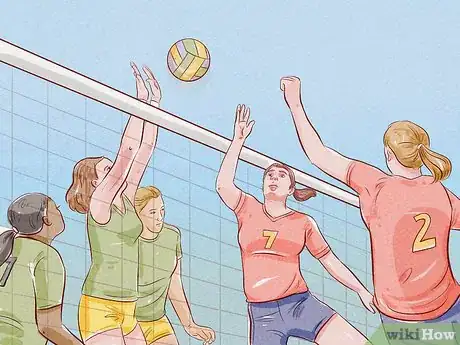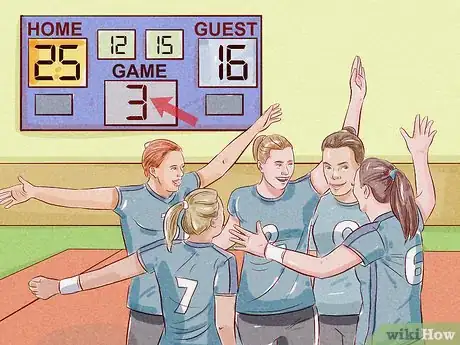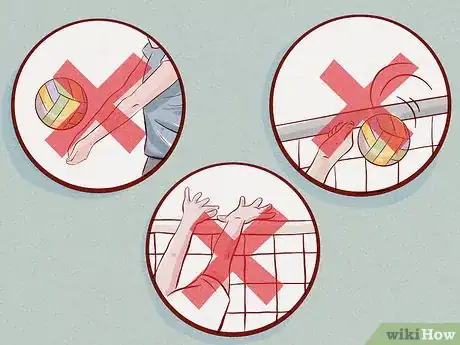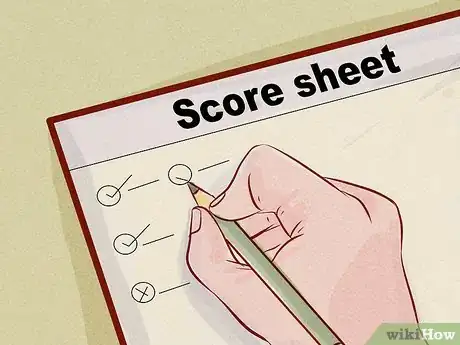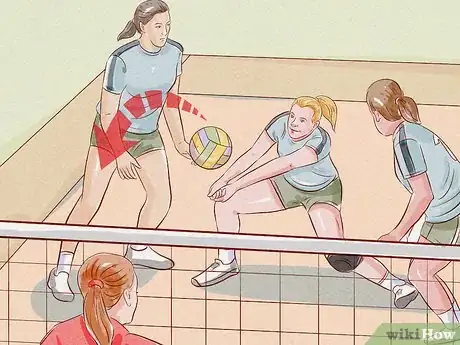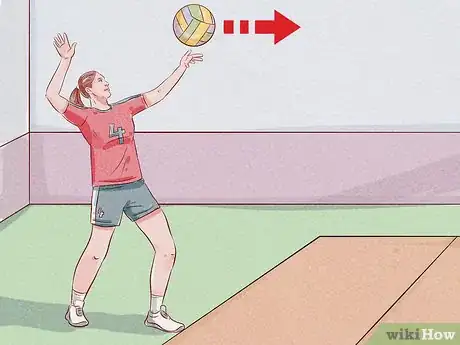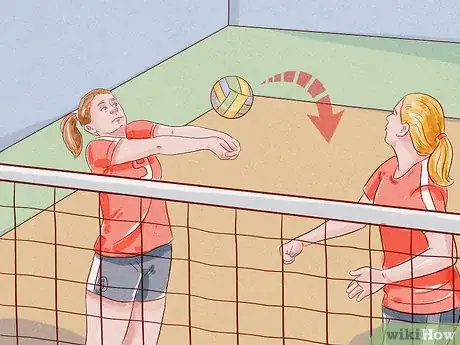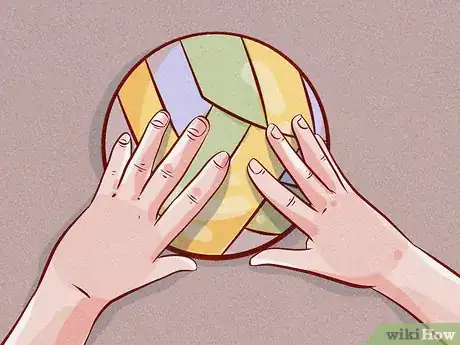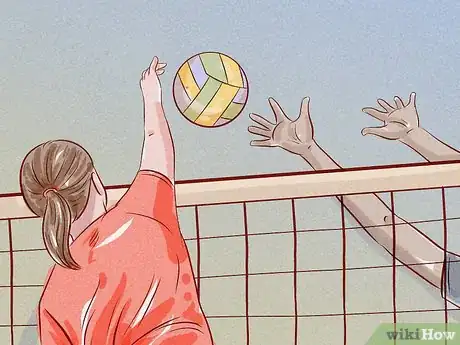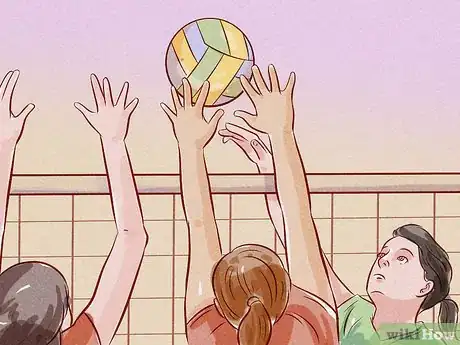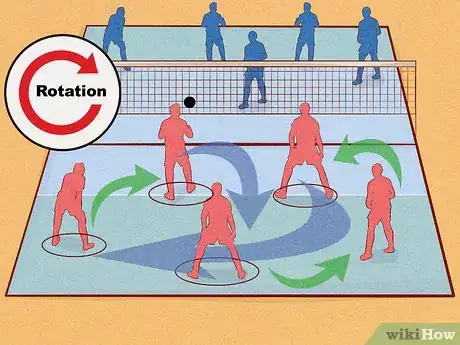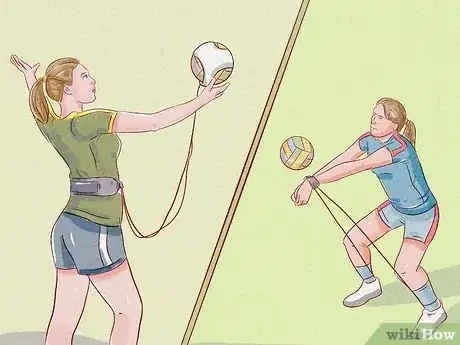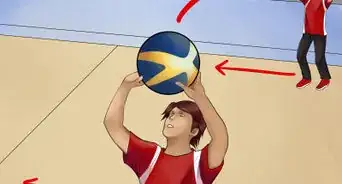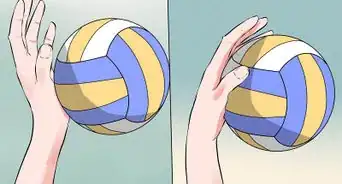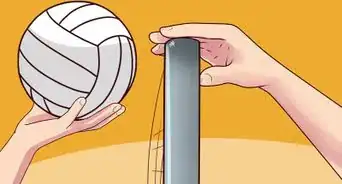This article was co-authored by wikiHow Staff. Our trained team of editors and researchers validate articles for accuracy and comprehensiveness. wikiHow's Content Management Team carefully monitors the work from our editorial staff to ensure that each article is backed by trusted research and meets our high quality standards.
There are 15 references cited in this article, which can be found at the bottom of the page.
This article has been viewed 91,381 times.
Learn more...
Volleyball is a fast-paced, exciting team sport enjoyed all over the world. Winning a volleyball game requires you to score points, and scoring points requires you to master fundamental offensive and defensive skills while also working together with your team. We'll fill you in on how scoring works in a standard game and show some key techniques to setting up and securing points with your team.
Things You Should Know
- Score 1 point by touching the ball to the ground on the other team's side of the net.
- Win the game by being the first team to score 25 points, while avoiding faults, which give the other team points.
- Work together with your team to set up powerful spikes, which rocket the ball toward the floor.
Steps
How Scoring Works
-
1Score 1 point every time the ball touches the floor on the opponent's side. Teams take turns sending the ball over the net to the other side. Each team can only touch the ball 3 times in a row before they must hit it to the other side. If the ball touches the floor on one team's side, the other team gains 1 point.[1]
- Each round or point in volleyball is called a "rally."
- Rallies begin with one team serving the ball to the other team.
-
2Familiarize yourself with rally scoring. Originally, the rules of volleyball stated that only the team serving could score a point. This provision has since been updated—now, either team can score, regardless of which team served the ball. The modern form of scorekeeping in volleyball is known as “rally scoring.”
- Always be looking for an opportunity to score, whether your team is serving or receiving.
- Rally scoring keeps games fast-paced, competitive, and fair.
Advertisement -
3Know who can legally score during play. During a volleyball match, there are rules about which players are allowed to contact the ball and when. Front row players are responsible for setting up and pulling off attacks, while back row players are generally forbidden from striking the ball. In situations where a back row player jumps from behind the attack line, however, a strike may be considered legal.[2]
- Players in the back row cannot attack from in front of the attack line.
- It's legal for front-row players to reach over the net to make a block, but only after the opposing team has made contact with the ball 3 times.
-
4Be the first team to score 25 points. These days, league volleyball games are almost always played to 25 points. However, the winning team must be ahead by at least 2 points by the end of the game. If neither team has a 2-point lead by the time they reach 25 points, the game will continue until one of them achieves a decisive victory.
- There’s no point cap in professional volleyball, which means that a could theoretically continue indefinitely if neither team manages to secure a 2-point advantage.
- 25 points may sound like a lot, but between quick scores and faults, a competitive game can be over in a flash.
-
5Win the best of 5 games to take the match. Volleyball matches are played using a multiple-game system, similar to sports like tennis. The first team to win 3 games is declared the winner. This keeps play exciting and unpredictable, as rival teams can trade victories right up until the end.[3]
- The final game in the series is sometimes played to 15 points rather than the traditional 25.[4]
- Stay focused. Even if you’ve won the first 2 games, it’s still possible for the opposing team to rally and neutralize your advantage if you begin playing carelessly.
-
6Avoid giving up points on a fault. Making a clean hit isn’t the only way to score in volleyball. A point will also be awarded or deducted whenever you or the opposing team commits a technical foul. Penalty fouls in volleyball include:
- Faulting on a serve.
- Making contact with the ball more than 3 times before successfully getting it over the net.
- Hitting the ball out of bounds without a player from the opposing team first touching it.
- Attempting to block a hit from the opposite side of the net.
- Touching the net while the ball is in play.
-
7Use a score sheet to keep track of points. During competitive play, a judge or referee will ordinarily be responsible for scoring. If you’re playing for fun, you can print an official score sheet off the internet, or devise your own simple version to keep things simple. Write the names of the two teams at the top and make a notch anytime one team scores.[5]
- Make sure the scoring sheet you’re using provides spaces to list other important details such as players’ names, numbers, serving orders, and substitutions.
- For league games, you may also want to put down the time, date, and location of the match.
Setting up a Score
-
1Score points by grounding the ball on the opponent’s side of the net. Each time you manage to strike the ball to the floor, or the opposing team fails to keep it in the air or return it, your team will get one point. It’s critical that the ball fall within the legal boundaries. Otherwise, it will be considered out of bounds, and the point will be denied or even ruled a fault.[6]
- The key to winning is positioning and coordinating your team so that you have the best chance of scoring without leaving openings to be scored on yourself.
- An experienced referee with a good eye can be instrumental in arbitrating controversial plays.
-
2Perfect your serve. During the opening play of the match, the player serving sends the ball sailing over the net, inviting the opposing team to return. When delivered with power and precision, well-placed serve can score an immediate point for the offensive team. Even when successfully defended, it gives the serving team more time to set up for the next play in the rally.[7]
- A point scored on a serve (whether the result of a clean strike or failure of the receiving team to keep the ball in play) is referred to as an "ace."[8]
- Overhand serves are more difficult to pull off, but are also harder to defend than underhand serves.
- Be careful not to cross the court's end line while serving, or it could be declared a fault.
-
3Improve your passing skills. Strategic passing allows your team to get the ball into a better position to return or attempt a strike. Generally, it's a good idea to give final possession of the ball to the player with the strongest offensive skills to maximize your scoring potential and keep the opposing team on their heels.
- When passing the ball, always make contact with the fleshy part of your forearms rather than your hands or wrists. Over time, too much force can cause stress to the small bones in these areas.
- Remember that your team only has 3 chances to return a ball falling on your side of the net before it's ruled a fault.
-
4Practice setting. The purpose of setting is to control the ball in preparation for a strike. Skillful setting provides your team's hitters with a clearer angle of attack and allows them to the drive ball at such a high velocity that it's nearly impossible to return.[9]
- Coordinate with your team so that the hitter is in position and ready to strike as soon as the set ball reaches its highest point above the net.
- A set is also sometimes referred to as an "overhead pass."
-
5Develop your striking technique. Once the setter has elevated the ball, the striker will attempt to fire it straight through the opposing team's defense. As the ball approaches, squat low and jump to meet it. Strike the ball with the flat of your palm the way you would during an overhand serve. If they're unable to return your strike your team will earn a point.[10]
- Try to maneuver the ball as far away from the opposing team's defensive players as possible.
- In most games, the majority of the points your team scores will be due to unblocked strikes.
-
6Build a solid block to set up a score as the receiving team. A strong offense alone doesn't win volleyball games. Establishing an ironclad defense with your teammates is essential for preventing the opposing team from scoring. It also forces them to make split-second returns if the ball happens to fall on their side of the net, which can help slow down an offensive assault and even lead to faults in your team's favor.[11]
- Under most competitive rules, the trio of players closest to the front of the net will be responsible for blocking.
- If a blocked ball falls on your side of the net, your team will still have 3 chances to return it.
Working as a Team
-
1Pay close attention to your rotation. In most sports, a player's position determines their location on the field or court. In volleyball, however, each player moves in a clockwise direction prior to every serve. It's important that you and your teammates stay on top of the ongoing rotation and become confident playing from every possible position.[12]
- Your position in the rotation is not the same as your player position. Defensive players, for instance, will remain on the defensive until the rotation shifts them to the front of the court.[13]
- Playing out of the correct rotation could earn you a fault or even cause you to lose a point.
-
2Drill team plays constantly. Sharpening your own technique will only get you so far. In order to increase your scoring potential during competitive play, it will be necessary to practice as a unit with your entire team. Ultimately, teamwork is more important when it comes to consistent scoring than having the hardest strike or the best block.[14]
- Be sure to incorporate both offensive and defensive drills into your practice to get some experience playing both sides of the net.[15]
- If possible, break into smaller teams and face off in a scrimmage to simulate competitive play and enhance your ability to come out on top in fast-paced rallies.
-
3Practice frequently. Regular practice is key to maintaining and developing your skills, both as an individual player and as a team. A good coach will keep you on a tight practice schedule and look for ways to bring the best out of each player.[16]
- Teams who practice hard play hard. Treat your practice sessions with the same seriousness you would a championship-level game.
Community Q&A
-
QuestionHow many points are in a volleyball game?
 DonaganTop AnswererThis varies somewhat depending on the setting. Typically, teams will play to 25 points, but must win by at least two points, so that the score could go higher than 25. In some cases, teams might play to 21 point,s or even 15. Each league make its own scoring rules.
DonaganTop AnswererThis varies somewhat depending on the setting. Typically, teams will play to 25 points, but must win by at least two points, so that the score could go higher than 25. In some cases, teams might play to 21 point,s or even 15. Each league make its own scoring rules. -
QuestionWhy does one member of a team wear a different-colored shirt to the rest of the team?
 DonaganTop AnswererThat player is called the "libero." S/he is brought into games for defensive purposes and is not involved in attacking the opponents. S/he plays only in the back row. The libero wears a different shirt because different rules apply to her/him, and so s/he must be clearly identified.
DonaganTop AnswererThat player is called the "libero." S/he is brought into games for defensive purposes and is not involved in attacking the opponents. S/he plays only in the back row. The libero wears a different shirt because different rules apply to her/him, and so s/he must be clearly identified. -
QuestionHow do I score a forfeit in volleyball?
 Community AnswerIf the other team doesn’t show up or doesn’t have enough players to play, then your team wins by forfeit.
Community AnswerIf the other team doesn’t show up or doesn’t have enough players to play, then your team wins by forfeit.
References
- ↑ https://usavolleyball.org/play/rules-of-volleyball/
- ↑ https://www.fivb.com/en/refereeingandrules/rulesofthegame_vb
- ↑ https://www.youtube.com/watch?v=SJCssiWmO-k&feature=youtu.be&t=65
- ↑ https://www.yourschoolgames.com/coronavirus-support/ngb-activities/volleyball/
- ↑ https://ncva.com/downloads/Referee%20Scoresheet.pdf
- ↑ http://www.reilycenter.com/index.php/intramuralsports/rules-volleyball/
- ↑ https://www.fivb.org/en/beachvolleyball/Glossary.asp
- ↑ https://healthfully.com/what-volleyball-ace-4602361.html
- ↑ https://www.youtube.com/watch?v=h5mpBCRK_yk&feature=youtu.be&t=11
- ↑ http://www.strength-and-power-for-volleyball.com/volleyball-approaches.html
- ↑ http://www.volleyballadvisors.com/volleyball-blocking.html
- ↑ https://www.fivb.org/en/beachvolleyball/Glossary.asp
- ↑ https://www.myactivesg.com/sports/volleyball/how-to-play/volleyball-for-beginners/volleyball-rotation-rules
- ↑ https://www.avca.org/Blog/Article/9/Four-Areas-to-Maximize-your-Team-s-Practice-Session
- ↑ http://www.volleyballadvisors.com/volleyball-team-drills.html
- ↑ http://www.volleyballadvisors.com/volleyball-drills.html
About This Article
To score in volleyball, communicate with your team to set up opportunities for getting the ball over the net where the other team can’t hit it. You can do this by bumping the ball with your forearms to a different player, called passing. Alternatively, you might set the ball for another player to hit, or strike the ball to score a point. Additionally, you can score on a serve by hitting the ball powerfully to a spot where the other team won’t be able to hit it. Run drills with your teammates to practice different techniques for scoring and perfect your form. If you want to learn how to block the ball to prevent the other team from scoring, keep reading the article!
